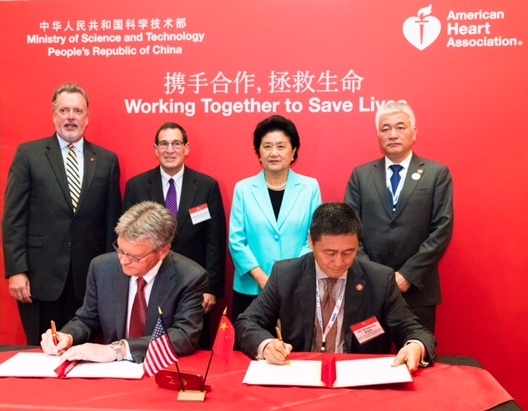Tang Ziren is an emergency physician at Chao-Yang Hospital in Beijing, a large facility that's been rated among the best in all of China in a survey by the nation's Ministry of Health.
After 20 years there, officials rewarded Dr. Tang with a trip to the United States this spring for a bit more training.
He went to the Weil Institute of Critical Care Medicine in Rancho Mirage, California. He took courses in CPR and Critical Care, and an American Heart Association course in Basic Life Safety.
He also took some time to have a little fun.
One of his excursions was to San Diego, and one of his destinations was Sea World. While he was there, he was forced to put his newly honed skills into action.
It started with a scream. Dr. Tang heard it, looked around and saw a woman on the ground about 35 feet away. He instinctively rushed to her.
She was unconscious, and a man he believed to be her husband was trying to wake her up. A young boy with them -- a grandson, perhaps -- was clearly frightened. Dr. Tang told someone to call 911, then he checked the woman for a pulse and for breathing.
He found neither.
"I'm an emergency physician from China," he told the man. "She needs CPR. Can I administer it?"
Dr. Tang gave compressions for about 10 minutes until park personnel arrived with an automated external defibrillator (AED). When the first shock didn't jolt her heart back into a sustainable rhythm, they used the machine again. This time, her heart responded.
Paramedics arrived just about then. As they prepared to load the woman into the ambulance, Dr. Tang stood near her head, offering encouraging words.
"At that point, she could open her eyes. That's a sign of successful emergency CPR," he said. "I felt a great sense of achievement. That's a great feeling."
How cool is that?
This doctor-turned-tourist, this visitor from China checking out such an utterly American locale, proved to be the right person in the right place at the right time.
In a nutshell, that's what CPR training is all about: Turning more people in potential lifesavers because you just never know when those skills will be needed.
I'm proud that my organization, the American Heart Association, helped pioneer CPR more than 50 years ago, and continues to refine this lifesaving technique. We train more than 16 million people in CPR, First Aid or Advanced Life Support programs each year in more than 100 countries.
Our push to require CPR training as a requirement for high school graduation continues to gain steam. And just a few weeks ago, we made an announcement that could lead to scenes like Dr. Tang at Sea World becoming more common in his homeland.

American Heart Association volunteer Douglas Boyle and Director General Jin Xiaoming of the China Ministry of Science and Technology sign an agreement to work together to reduce heart disease and stroke in China.
The Chinese government has signed an agreement to work with the AHA to train more of their citizens in this lifesaving skill. The impact of this is potentially transformational.
- There are nearly 1.4 billion people in China, and about 290 million have cardiovascular diseases.
- If just 5 percent of China's population becomes CPR-trained, roughly 70 million more people would know how to respond to a cardiac arrest.
- It's also important to note that about 70 percent of cardiac arrests happen in the home, meaning empowering laymen can be the difference between life and death.
"CPR is not just a technique for doctors," Dr. Tang said. "If members of the public know how to administer CPR, they can start first aid immediately. And those first few minutes are vital to a patient's recovery."
The new agreement between the AHA and China's Ministry of Science and Technology also includes a physician exchange program to improve cardiovascular care and health in both countries, as well as greater sharing of each nation's scientific research at AHA conferences and medical meetings in China.
The agreement comes after a year of talks that had the AHA and China looking for ways to impact health in a country where cardiovascular diseases are taking a heavy toll.
About 3.5 million people die from cardiovascular diseases every year in China, according to data from a 2012 report from the National Center for Cardiovascular Diseases of China. That represents about 41 percent of all deaths in China. This figure is markedly higher than the 31 percent rate in the United States, where cardiovascular death rates have been dropping in recent years.
Seeing the smiles on the faces of the officials implementing this plan is gratifying. So is the excitement from someone in the middle of the action like Dr. Tang.
He said he's thrilled to know the Chinese government will be promoting CPR awareness and training. He's also thrilled they are relying on the proven knowledge from the AHA. He noted that AHA's CPR Guidelines are known in his country as "the guide," and they are treated as the gold standard of care; that's why he came to the United States for that additional training.
"This work will help improve public health enormously," he said. "It will mean that more people, many more people, learn CPR technique, and they will save more lives, and more families. That's a dream for us doctors. I hope that we have the opportunity to join hands and work together to save lives."
